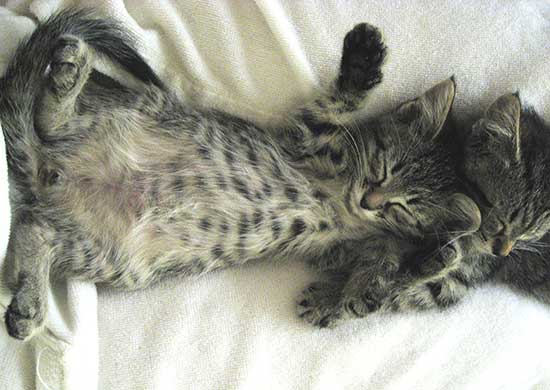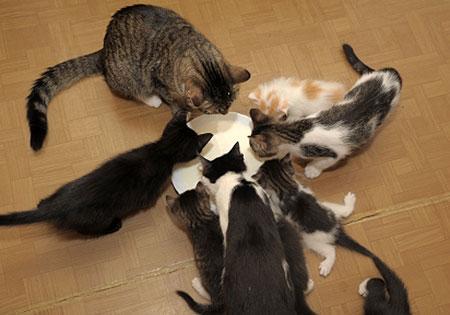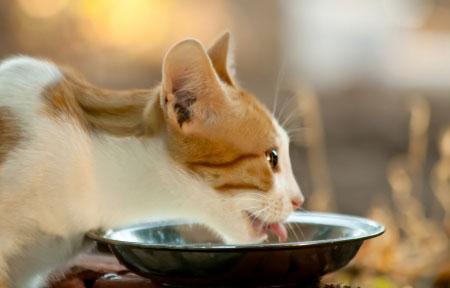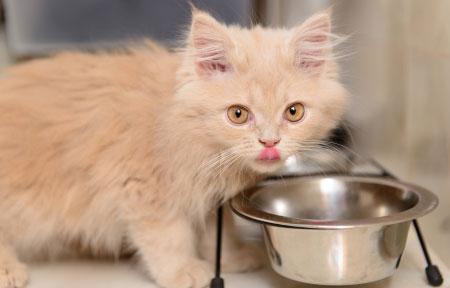This content is archived from the Feline Nutrition Foundation
Your Cat's Nutritional Needs: The Basics
- Updated: Saturday, June 01, 2019 04:56 PM
- Published: Tuesday, February 09, 2010 04:22 AM
- Written by Kymythy R. Schultze, CN
 This article discusses the basic nutritional needs of your cat. Many nutrients have been studied individually in a clinical setting – in fact, they're examined more individually than in the food they came from. This is unfortunate because it's important to remember that the essential building blocks of health aren't isolated in nature. Whole foods contain a complex blend of synergistic compounds that work together to support optimal well-being. While that may sound complicated, it really isn't – if you simply use species-appropriate real food as the foundation for health. One of the great things about feeding our cats a well-prepared diet of real food is that it's chock-full of all the nutrients we know are important to feline health. Plus, we're also including natural nutrients that have yet to be isolated, synthesized, and added to the cans and bags of processed pet food. It's more complicated for pet-food manufacturers who formulate products with isolated ingredients to make an appropriate substance that mimics real food in supporting a lifetime of great health for your cat.
This article discusses the basic nutritional needs of your cat. Many nutrients have been studied individually in a clinical setting – in fact, they're examined more individually than in the food they came from. This is unfortunate because it's important to remember that the essential building blocks of health aren't isolated in nature. Whole foods contain a complex blend of synergistic compounds that work together to support optimal well-being. While that may sound complicated, it really isn't – if you simply use species-appropriate real food as the foundation for health. One of the great things about feeding our cats a well-prepared diet of real food is that it's chock-full of all the nutrients we know are important to feline health. Plus, we're also including natural nutrients that have yet to be isolated, synthesized, and added to the cans and bags of processed pet food. It's more complicated for pet-food manufacturers who formulate products with isolated ingredients to make an appropriate substance that mimics real food in supporting a lifetime of great health for your cat.
Take the taurine disaster, for example. Taurine is an amino acid that pet-food manufacturers didn't consider essential until cats began to suffer and die from eating processed products deficient in it, Now it's an isolated chemical added to most cat foods, but if you're considering feeding your cat real food, I have great news: The first food group we'll discuss is a fantastic source of natural taurine!
Protein. Dietary protein supplies essential amino acids and is needed for the manufacture of antibodies, enzymes, hormones, and tissues and for proper pH balance. It provides energy for cats and is essential for growth and development. Complete proteins contain ample amounts of essential amino acids and are found in foods such as meat, fish, eggs, and poultry. Incomplete proteins do not provide all essential amino acids and are found in many foods, including legumes, grains, and vegetables. These plant proteins don't supply the essential amino acids that a cat needs (such as taurine), which come from animal protein.
Cats need animal sources of this nutrient, as the amino acids from vegetable sources aren't well utilized. How much each animal may need can vary slightly due to a variety of factors, including physiological state, age, activity, and the digestibility of the protein source being fed. Overall, cats have a very high requirement for protein.
Fat. This concentrated source of energy also provides essential fatty acids and aids in nutrient utilization and transportation. It's involved in cell integrity and metabolic regulation as well. Saturated fat is found primarily in animal sources, while polyunsaturated fat comes mostly from plants.
Fats (and oils) are composed of fatty acids, sometimes referred to as "vitamin F." The following are the fatty acids most involved in feline health: omega-3 fatty acids, which include alpha-linolenic acid, eicosapentaenoic acid, and docosahexaenoic acid; and omega-6 fatty acids, including linoleic acid, gamma-linolenic acid, arachidonic acid, and conjugated linoleic acid.
 Linoleic and arachidonic acids have long been considered to be essential fatty acids for cats. More recently, DHA has been added due to its important contribution to feline vision, reproductive health, and the immune system. EPA may also be of benefit.
Linoleic and arachidonic acids have long been considered to be essential fatty acids for cats. More recently, DHA has been added due to its important contribution to feline vision, reproductive health, and the immune system. EPA may also be of benefit.
Essential fatty acids are just what they sound like – essential for the cat's health – and they must be obtained from food sources. Unlike some animals, felines don't efficiently convert plant sources of EFAs to the needed derivatives. For example, cats must eat meat to obtain arachidonic acid. Also, they don't convert LA to GLA (as some animals do), and studies show that GLA can benefit the health of feline skin and coat. We can theorize that in nature, the cat would eat another animal whose body had already made the conversion, thereby offering some of this useful fatty acid. The cat would also consume omega-3s and CLA when eating its natural herbivorous prey.
To sum up, LA; AA; DHA (which is mostly found in nature with other useful omega-3s); and to a lesser extent, EPA and GLA, can be considered important fatty acids for good feline health. CLA may become recognized as a bigger player in feline nutrition in the future because it's found in the meat and fat of a cat's natural diet, but it has only recently been "discovered" by nutritional science.
Minerals. These are essential to the cat and are involved in almost all physiological reactions. They contribute to enzyme formation, pH balance, nutrient utilization, and oxygen transportation and are stored in bone and muscle tissue. Biological availability may vary widely depending on the source of the nutrient. Elemental minerals are generally taken from the earth or water; chelated minerals are those that are bound with other organic substances, often making them easier for the body to absorb.
Minerals include calcium, chloride, chromium, cobalt, copper, fluorine, iodine, iron, magnesium, manganese, molybdenum, phosphorous, potassium, selenium, silicon, sodium, sulfur, and zinc. There are others that cats require at trace concentrations. Minerals, like vitamins, work synergistically, with a cooperative action between them.
Vitamins. These nutrients are essential for metabolism regulation and normal growth and function. Usually found in food, some are synthesized within the animal's body. They're classified as either fat or water soluble.
Fat-soluble vitamins include A, D, E, and K. The water-soluble group includes C and the B complex. Generally, fat-soluble vitamins are stored in the body, while water-soluble ones pass through more quickly. Once again, the carnivorous cat utilizes animal sources of nutrients more readily than plant sources. For example, felines can't convert beta-carotene from plants into vitamin A (as some animals do), so they need preformed vitamin A from an animal source. This type needs no conversion.

Water. Because cats are designed to fulfill most of their water requirements by eating fresh raw food, they naturally have a low thirst drive. This can lead to health issues when they eat dry food products and treats. One of the problems is that even though they become dehydrated eating the kibble, their natural "programming" may not encourage them to drink more, and their urine can become too concentrated. Even though a healthy cat doesn't drink much, you should always have clean drinking water available. And please make sure it's good quality, which means that just turning on the faucet may be out, especially if your community puts fluoride in the water supply. If you have a well, get it tested annually for contaminants.
But Wait…There's More!
There are a number of other substances that contribute to good health, some of which come from food sources and some of which are created within the body. These include antioxidants – comprising vitamins, minerals, and enzymes – which help protect the body from damaging free radicals. Now, I know that "free radicals" sound like a terrorist group, but they're actually cell-damaging atoms. Hmm…I guess you could consider them a form of body terrorist! Free radicals may be formed internally by exposure to cigarette smoke, pollution, radiation, and other damaging substances. With our cats being bombarded with more environmental toxins than ever before, antioxidants are important factors for good health.
Enzymes are protein molecules that are essential for most bodily functions. They're involved in energy, tissue, organ and cellular repair and much more. They're also essential for digestion, and different species of animals need different levels for particular types of food. Not surprisingly, creatures have the enzymes needed to properly break down the foods found in their natural diets and tend to be deficient in those that work on substances they wouldn't eat in the wild.
In addition to being manufactured by the body, enzymes can also be found in food, although temperatures of 118 degrees (F) or above destroy them. Those in raw ingredients help prevent depletion of the body's internal supply of enzymes.
There are probably many more nutrients yet to be discovered, but that's the great thing about feeding fresh food – those undiscovered, yet important, substances are already in there!
What's Not Nutritionally Required
You may have noticed that carbohydrates (usually supplied by grains in pet food) weren't listed among the necessary nutrients for cats. Even the National Research Council's Subcommittee on Cat Nutrition states that "…no known dietary carbohydrate requirement exists for the cat…" And really, if you consider feline physiology and what the species has been eating for thousands of years, it makes perfect sense that grains shouldn't be part of the cat's diet.
Another good reason not to feed grain is the fact that it breaks down into sugar within the body – something a cat definitely doesn't need! Many studies link sugar consumption to illness, including cancer.¹ Eating a high-carb diet really wreaks havoc on a cat's body. Carbs are usually thought of as energy foods, but felines utilize protein and fat very efficiently for those needs. This is one reason why cats have such a high requirement for quality protein.
Good Nutrition is a Team Effort
 All the components we discussed don't work alone in nature; foods don't contain single nutrients. For example, we've probably all heard that oranges are a good source of vitamin C, but that piece of fruit contains many other cofactor nutrients that actually aid in the absorption and utilization of the vitamin. Even if farmers created a "Franken-orange" that contained only that vitamin, it wouldn't be as effective without the other "helpers," such as bioflavonoids and minerals that aid in vitamin C's effectiveness.
All the components we discussed don't work alone in nature; foods don't contain single nutrients. For example, we've probably all heard that oranges are a good source of vitamin C, but that piece of fruit contains many other cofactor nutrients that actually aid in the absorption and utilization of the vitamin. Even if farmers created a "Franken-orange" that contained only that vitamin, it wouldn't be as effective without the other "helpers," such as bioflavonoids and minerals that aid in vitamin C's effectiveness.
Likewise, vitamin E isn't simply the d-alphatocopherol that you'll find in a capsule from the store. It's actually a family of at least eight different molecules that work better when taken together, the way they're found in fresh food, rather than alone in supplemental form. Many studies have shown that natural nutrients from food are more beneficial than isolated synthetic supplements.² And by the way, oranges aren't a species-appropriate source of vitamin C for cats, but raw liver is.
Additional Reading
Answers: Goaltending the Cat Food Bowl
Care to Compare? Wild vs. Domesticated Prey
Nonfood Requirements
Your cat has other needs in addition to a good diet. Yes, food is the foundation of health, but there are other factors that can have a big impact on your feline friend's well-being. Of course it needs a clean, accessible litter box and a safe place to call its own, but your cat also needs you.
Even though cats are perceived as very independent creatures, they really do benefit from your love and attention. Please talk to, play with, and touch your cats in ways they enjoy. I promise that if you make them an important part of your life and treat them with love and respect, you'll all benefit immeasurably.
Kymythy R. Schultze has been a trailblazer in the field of animal nutrition for nearly two decades. She's a Clinical Nutritionist, a Certified Nutritional Consultant and one of the world's leading experts on nutrition and care for cats. Visit her at Kymythy.com. "Your Cat's Nutritional Needs: The Basics" is chapter 3 of Kymythy's book Natural Nutrition for Cats, The Path to Purr-fect Health, and is posted here with her kind permission.
1. "Dietary Glycemic Load and Risk of Colorectal Cancer in the Women's Health Study," Journal of the National Cancer Institute 96, no. 3, 2004.
"Consumption of Sugar and Sugar-Sweetened Food and the Risk of Pancreatic Cancer in a Prospective Study," American Journal of Clinical Nutrition, November 8, 2006.
2. "Vitamin E," Office of Dietary Supplements, National Institutes of Health, December 2009.




